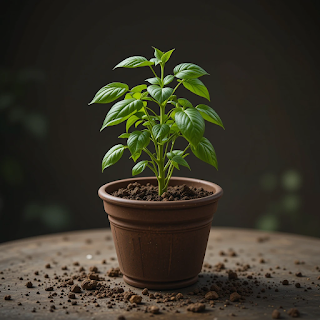How to Grow Basil: A Complete Guide
Basil is one of the most beloved culinary herbs, prized for its aromatic leaves and versatile uses in cooking. Whether you're growing it in a container on your windowsill or in your garden beds, basil is relatively easy to grow and incredibly rewarding. This guide will walk you through everything you need to know to successfully grow thriving basil plants.
Getting Started with Basil
Varieties to Consider
- Sweet Basil (Genovese): The classic Italian variety, perfect for pesto
- Thai Basil: Spicy with anise notes, holds up well in cooking
- Purple Basil: Striking color with slightly spicy flavor
- Lemon Basil: Bright citrus aroma
- Cinnamon Basil: Sweet with mild cinnamon undertones
Planting Conditions
Timing
- Start seeds indoors 6-8 weeks before last spring frost
- Plant outdoors after all danger of frost has passed and soil is warm
- Soil temperature should be at least 50°F (10°C), ideally 70°F (21°C)
Temperature Preferences
- Optimal growing temperature: 80-90°F (27-32°C)
- Minimum temperature: 50°F (10°C)
- Basil is extremely frost-sensitive - even temperatures in the 40s can damage plants
Light Requirements
- Full sun: At least 6-8 hours of direct sunlight daily
- In very hot climates, afternoon shade can be beneficial
- Indoor basil needs the brightest window possible (south-facing ideal)
Soil Needs
- Well-draining, fertile soil with pH 6.0-7.5
- Rich in organic matter
- Loamy soil produces the best results
Planting Details
From Seeds
- Days to germination: 5-10 days under optimal conditions
- Plant seeds ¼ inch deep
- Keep soil consistently moist until germination
- Optimal germination temperature: 70-75°F (21-24°C)
Spacing
- Plants in garden: Space 12-18 inches apart
- Row spacing: 18-24 inches between rows
- Container planting: One plant per 8-inch pot, or 3 plants in a 12-inch pot
Care and Maintenance
Watering
- Keep soil consistently moist but not waterlogged
- Water deeply when the top inch of soil feels dry
- Water at the base to avoid wetting leaves
- Morning watering is preferable to prevent disease
Fertilizing
- Apply balanced organic fertilizer (like fish emulsion) every 4-6 weeks
- Container plants may need more frequent feeding (every 3-4 weeks)
- Avoid over-fertilizing as it can reduce flavor intensity
Pruning and Harvesting
- Begin harvesting when plants reach 6-8 inches tall
- Regular pruning is crucial for bushy, productive plants
- Pinch off flower buds as soon as they appear to extend the growing season
- When harvesting, cut stems just above a pair of leaves to encourage branching
- Never remove more than ⅓ of the plant at one time
Companion Planting
- Good companions: Tomatoes, peppers, oregano, parsley
- Poor companions: Rue and sage (can inhibit growth)
Common Problems
Pests
- Aphids: Spray with water or insecticidal soap
- Japanese beetles: Hand-pick or use row covers
- Slugs: Create barriers with diatomaceous earth or copper tape
Diseases
- Fusarium wilt: Use resistant varieties and practice crop rotation
- Downy mildew: Improve air circulation, avoid overhead watering
- Root rot: Ensure proper drainage, don't overwater
Growing Basil Indoors
- Place near the sunniest window available
- Supplement with grow lights during winter months
- Rotate the plant regularly for even growth
- Indoor plants often need less water than outdoor ones
- Ensure good air circulation to prevent fungal issues
Harvesting and Storage
- Harvest in the morning when oil content in leaves is highest
- Regular harvesting encourages bushy growth
- For fresh use: Store stems in water like flowers (room temperature)
- For preservation: Freeze chopped leaves in olive oil in ice cube trays
- Dried basil retains only a fraction of its flavor - freezing is better
Tips for Success
- Pinch early and often to create bushier plants with more leaves
- Protect from cold snaps even in summer - basil is very cold-sensitive
- Harvest entire stems rather than individual leaves for stronger plants
- If growing from cuttings, root them in water before planting in soil
- Succession planting every few weeks ensures continuous harvest
Basil is not only delicious but also beautiful and aromatic in the garden. With these guidelines, you'll be able to grow an abundant supply of this versatile herb throughout the growing season. Fresh basil elevates countless dishes, from classic Italian fare to Asian cuisine and refreshing summer drinks. Happy growing!




.jpg)



No comments:
Post a Comment